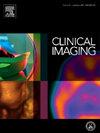Diagnostic performance of abbreviated non-contrast MRI for liver metastases in patients with newly diagnosed breast cancer
IF 1.8
4区 医学
Q3 RADIOLOGY, NUCLEAR MEDICINE & MEDICAL IMAGING
引用次数: 0
Abstract
Purpose
To compare the diagnostic performance of non-contrast abbreviated liver MRI (abMRI) and standard MRI (sMRI) with gadoxetic acid enhancement in the detection of liver metastasis during the initial workup for patients with breast cancer.
Methods
Of 7621 patients diagnosed with breast cancer who underwent abdominopelvic CT for their initial staging, 222 underwent sMRI between January 2016 and June 2019 to evaluate and/or characterize CT-indeterminate liver lesions. The abMRI protocol included diffusion-weighted images, apparent diffusion coefficient maps, and T2-weighted fat-suppression images, while the reference standard was histopathology or composite imaging follow-up. Two radiologists utilized a five-point scale to determine the probability of malignancy for each lesion. The per-patient diagnostic parameters were compared using generalized estimating equation and chi-square test.
Results
A total of 222 female patients (age, 49.8 ± 10.4 years) including 17 with metastases (7.7 %) were included in the present analysis. When defining scores ≥4 as metastasis, there were no significant differences in the per-patient sensitivities (82.4 % vs. 82.4 %; p > 0.99), specificities (97.6 % vs. 98.1 %; p = 0.61), positive predictive values (73.7 % vs. 77.8 %; p = 0.63), negative predictive values (98.5 % vs. 98.5 %; p = 0.99), or accuracies (96.4 % vs. 96.9 %; p = 0.99) between the abMRI and sMRI groups, respectively. Additionally, there were no significant differences in the subgroups of patients with subcentimetre and stage II or higher disease.
Conclusion
During the patients' initial workup, the diagnostic performance of non-contrast abMRI was comparable to that of sMRI with gadoxetic acid for CT-indeterminate liver lesions.
求助全文
约1分钟内获得全文
求助全文
来源期刊

Clinical Imaging
医学-核医学
CiteScore
4.60
自引率
0.00%
发文量
265
审稿时长
35 days
期刊介绍:
The mission of Clinical Imaging is to publish, in a timely manner, the very best radiology research from the United States and around the world with special attention to the impact of medical imaging on patient care. The journal''s publications cover all imaging modalities, radiology issues related to patients, policy and practice improvements, and clinically-oriented imaging physics and informatics. The journal is a valuable resource for practicing radiologists, radiologists-in-training and other clinicians with an interest in imaging. Papers are carefully peer-reviewed and selected by our experienced subject editors who are leading experts spanning the range of imaging sub-specialties, which include:
-Body Imaging-
Breast Imaging-
Cardiothoracic Imaging-
Imaging Physics and Informatics-
Molecular Imaging and Nuclear Medicine-
Musculoskeletal and Emergency Imaging-
Neuroradiology-
Practice, Policy & Education-
Pediatric Imaging-
Vascular and Interventional Radiology
 求助内容:
求助内容: 应助结果提醒方式:
应助结果提醒方式:


